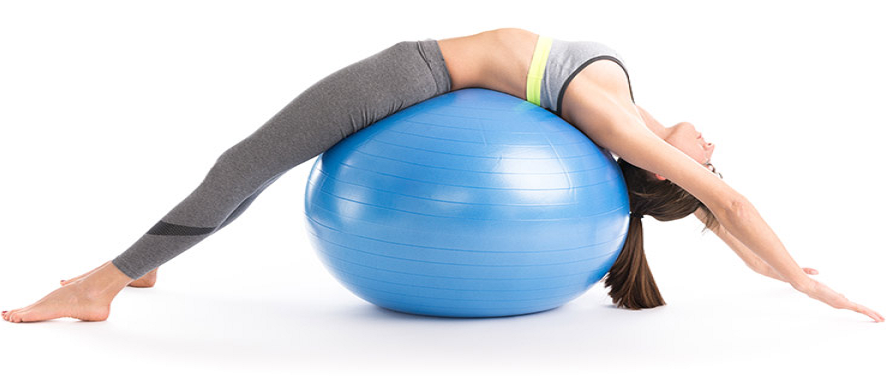The large exercise ball, known as the fitball, is a valuable tool for stretching the spine and extremities. The spherical shape of the exercise ball makes stretching the spine easier and more effective.
Stretching on the fitball can be performed by beginners and advanced athletes. The fitball is employed by therapy and injury rehabilitation centers throughout the world. Trainers of collegiate and professional sports teams use the fitball for stretching and strengthening.
The fitball is known by many names. These include therapy ball, stability ball, abdominal ball, ab ball, Swiss ball, fitness ball, fitball and gymball. To avoid confusion, I will refer to it as the fitball in this article.
The fitball is available in sizes from 45 cm to 85 cm in circumference. Always utilize the appropriate size ball for your height. This is especially important while stretching. For safety reasons you should keep either your hands or feet in contact with the floor for support at all times.
Stretching helps to reduce muscle tension, increase flexibility and improve range of motion. Reduced muscle tension lessens pain and increases movement fluidity. Greater flexibility is important in sports, work and motion. Increased pain-free range of motion is a common therapeutic goal and improves function.
Never stretch a cold muscle. The best time to execute stretching exercises is immediately following exercise. At this time the blood flow to the muscles is increased making the muscles more pliable. Take advantage of this situation to perform your slow static stretches.
Stretching is a very effective cool down activity. Following an exercise session hold slow static stretches to decrease muscles tension and increase flexibility.
Start at a level that is applicable for you when beginning an exercise program or implementing a new exercise type in your routine. Stretching is not a flexibility contest between you and others. Start slowly and progress in small increments. Work toward short term goals that move you in the direction of larger long-term health and fitness goals.
Stretching should never cause pain or elicit symptoms. If a specific stretch causes pain, numbness or burning, skip that stretch and proceed to the next one.
Exhale and move into a stretch slowly. Never bounce or move quickly when executing static stretching. Reach a point of slight muscle resistance and hold it. Never force the muscle to stretch further than it can. Gradually increase the length of a stretch when the tension lessens. Hold a comfortable stretch for 20 to 60 seconds.
Stretch your spinal muscles by lying prone over the exercise ball. Kneel behind the ball and place your chest and stomach on the ball. Keep your feet in contact with the floor for safety and support. Hold your arms out in front of you and place them on the floor as soon as you can reach. It’s okay if your feet come off the floor while your hands are supporting you.
Slowly roll forward over the ball. Move gradually to feel the muscles at each vertebral level stretch. The spinal area over the top of the ball will be stretched the most. Find a comfortable stretch in the area you want and hold it for 20 to 60 seconds. Exhale and relax completely to increase the stretch. Perform this exercise a total of two to four times daily or every other day.
Stretch the hip flexor muscles by lying supine over the exercise ball. This exercise may be difficult in the beginning due to balance factors. With constant practice, balancing yourself on the ball becomes easier. Always move slowly and keep your feet in contact with the floor.
Flexibility and correct motion of the muscles in the front of the hip is imperative for proper hip, pelvis and spinal movement. The strong hip flexor muscles attach to the spine, pelvis and thigh bones. The exercise ball provides a curved surface to make stretching the hip flexors more effective.
Sit in proper posture just in front of the highest point of the ball. Slowly roll forward until your lower back is contacting the top of the ball. Gradually let your upper body roll backward until your middle back contacts the ball. With your feet firmly on the floor, exhale and relax further. You should feel a stretch in the front of your thighs, pelvis and lower back. Find a comfortable stretch and hold it for 20 to 60 seconds. Execute a total of two to three times daily or every other day.
Implement these two stretches to develop greater flexibility in your spine, pelvis and hips. The benefit you receive from increased pain-free range of motion and decreased muscle tension improves your ability to perform activities of daily living and your athletic performance.
Dr Donald A Ozello DC of Championship Chiropractic in Las Vegas, NV
Web Site: http://www.championshipchiropractic.com/
Blog: https://www.championshipchiropractic.com/wordpress/
YouTube: https://www.youtube.com/user/drdozellodc/videos
Twitter: https://twitter.com/drdozellodc
Facebook: https://www.facebook.com/Championship-Chiropractic-280141628688300/
LinkedIn: https://www.linkedin.com/in/dr-donald-a-ozello-dc-716b3233
“Running: Maximize Performance & Minimize Injuries” https://www.amazon.com/Running-Performance-Chiropractors-Minimizing-Potential/dp/1493618741
**Disclaimer: Always consult a medical professional before beginning an exercise program. Always work within your capabilities. Never perform an exercise that elicits or increases pain or symptoms. Reading this article and viewing the linked videos does not take the place of seeing a medical professional. Please visit a medical professional for evaluation, diagnosis & treatment.

